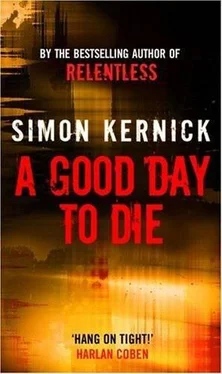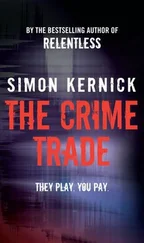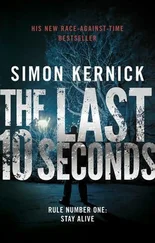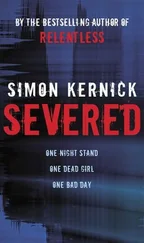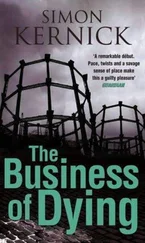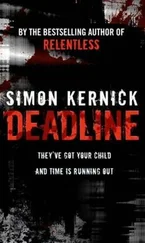Simon Kernick - A Good day to die
Здесь есть возможность читать онлайн «Simon Kernick - A Good day to die» весь текст электронной книги совершенно бесплатно (целиком полную версию без сокращений). В некоторых случаях можно слушать аудио, скачать через торрент в формате fb2 и присутствует краткое содержание. Жанр: Триллер, на английском языке. Описание произведения, (предисловие) а так же отзывы посетителей доступны на портале библиотеки ЛибКат.
- Название:A Good day to die
- Автор:
- Жанр:
- Год:неизвестен
- ISBN:нет данных
- Рейтинг книги:3 / 5. Голосов: 1
-
Избранное:Добавить в избранное
- Отзывы:
-
Ваша оценка:
- 60
- 1
- 2
- 3
- 4
- 5
A Good day to die: краткое содержание, описание и аннотация
Предлагаем к чтению аннотацию, описание, краткое содержание или предисловие (зависит от того, что написал сам автор книги «A Good day to die»). Если вы не нашли необходимую информацию о книге — напишите в комментариях, мы постараемся отыскать её.
A Good day to die — читать онлайн бесплатно полную книгу (весь текст) целиком
Ниже представлен текст книги, разбитый по страницам. Система сохранения места последней прочитанной страницы, позволяет с удобством читать онлайн бесплатно книгу «A Good day to die», без необходимости каждый раз заново искать на чём Вы остановились. Поставьте закладку, и сможете в любой момент перейти на страницу, на которой закончили чтение.
Интервал:
Закладка:
What struck me as I read was the sheer number of brutal crimes committed in the UK by people whose only motive seemed to be the sadistic gratification their violence gave them. In the Philippines, people killed. They killed a lot more than they did in England, as even the most cursory glance at Manila's murder statistics would demonstrate, but in general those killings were the direct result of poverty or ideology. Few people there murdered for pleasure. Here, where people had money and freedom, they did. It was a depressing thought, because it suggested that where the violence of humankind was concerned, things would never get better.
But for the moment, such lofty issues didn't concern me.
I kept reading. Trawling. Searching.
It was time-consuming work. I estimated I was taking about three minutes per issue, so each month was taking me more than an hour and a half. By the time I got to March, it was almost half past three and my eyes were hurting. I thought about stopping for a while, taking a break and ringing Emma to see if she'd arrived home, but I didn't want to lose my place at the machine. One more hour, then I'd call it a day.
1 March — nothing. 2 March — nothing. 3 March, something caught my eye. The bottom of the front page. I read it through; then read it again.
MAN ARRESTED AFTER DAUGHTER GOES MISSING
A thirty-six-year-old man has been arrested by police after his daughter was reported missing by neighbours. John Martin Robes of Stanmore, North London, was taken into custody by police investigating the disappearance of his twelve-year-old daughter, Heidi, who had not been seen for several days previously. Heidi's mother is not believed to live with the family and police were yesterday trying to trace her. Neighbours claim that Robes and his daughter could often be heard arguing loudly, and that Heidi had some behavioural problems. A spokesman for her school said that everyone there hoped and prayed that she would be found safe and well, but added that she had run away before.
There was no photograph.
I took out my notebook and wrote down the details. Then checked 4 March, this time the whole paper, but there was no further mention of the arrest or the fate of the missing girl. Sometimes when a kid from the wrong side of the tracks goes missing — and this is especially true when they've got a bit of a history — there's very little publicity surrounding the disappearance. It can be a lottery. A pretty, middle-class girl under the age of ten from the Home Counties is going to get a ton and a half of newsprint dedicated to her. A tough young thing of twelve, born and bred on a council estate and a teenager in all but name, just hasn't got the same selling power, and in the end, that's what it always comes down to.
But was she the girl I was looking for? I brought up the issue of 5 March, found nothing, then checked the 6th. There, on the right-hand column of page two was a short report sandwiched between news of a strike by Heathrow baggage-handlers and more Anglo-American bombing of Iraqi military installations. It stated that John Martin Robes had been charged with the murder of his daughter, Heidi, even though no body had been found, and was due to appear before magistrates that morning. Again there were no pictures of either accused or victim, but my interest was aroused, the main reason being the lack of a corpse. A corpse provides the police and the CPS with a lot of the evidence they need in order to secure a conviction. Take that away and nailing the killer becomes an uphill task. It made me wonder what it was the police had on Robes. The problem was it wasn't going to be that easy to find out. There was usually a minimum of six months between an arrest and a trial — it can sometimes take as long as a year — so it meant going through a lot more back issues of The Times, or finding a quicker means to locate the date. I decided to use the Web.
There were a number of PCs with Internet access tucked away on the opposite side of the room from the microfiche machines and I found one that was free. On the screen was a large icon representing something called The Times software. I clicked on it and a box appeared, prompting me to type in a keyword. I typed in the name 'John Robes' and looked at my watch. Five to four.
Five seconds later, a list of hits appeared in chronological order. At the top were the articles I'd already picked up in the March editions. After that there was nothing until 26 October, when a few brief lines outlined the first day of the trial of John Robes for the murder of his daughter. There was another piece on 28 October, detailing Robes's testimony on the witness stand, in which he'd tearfully denied all knowledge of his daughter's death, but had been unable to explain how a knife with her blood on it had been found in his house, as well as a bloodstained piece of her clothing. But the trial obviously hadn't caught the imagination of the media or the public, because again the article was short and there wasn't a further mention of the case until 3 November, when a headline announced that John Robes had been found guilty of murder and sentenced to life imprisonment.
I began reading the article. There were photographs this time — one of father, one of daughter. I only took the briefest look at him. He was a youngish-looking thirty-six, with an angular face and dark blond hair in a side parting, and in the photo he was smiling broadly. As is so often the case, he didn't look like a killer. And Heidi wasn't what I was expecting, either. She looked younger than twelve, with straight, light brown hair cut level with her chin and a much rounder face than her dad's. She was smiling too, in the same broad manner as the man who'd allegedly killed her, and her cheeks showed cute dimples. She didn't look like the sort of girl who had behavioural problems.
I stared at her image for a long time, knowing Dr Cheney's description, though very basic, matched with that of the girl smiling out at me. The years have been kind to me where tragedy is concerned, and I've learned to detach myself from the suffering of others, both those whose deaths I used to investigate and those I've caused. But the past few days had stretched that detachment to the limit. The murders of Ann Taylor and Andrea Bloom, two kids fighting against all the odds to make a life for themselves, coming after the death of my old friend Asif Malik, had hit me harder than I'd been prepared for. And now, as I sat there in the forced silence of that darkened windowless room on a cold December afternoon staring at the picture of a girl who'd died, helpless and alone, seven years earlier, for the first time in a long while I felt like crying.
Turning away from the pictures, I scrolled down and continued reading. John Robes, the article stated, had been found guilty of murder after a trial lasting just over a week. Once again, the fact that no body had been found was mentioned, but the forensic evidence of the knife and the clothing, coupled with the further discovery of a bloodstained gardening glove which two witnesses claimed to have seen in Robes's possession in the weeks prior to Heidi's disappearance, proved damning.
Robes had also admitted to having had a violent argument with his daughter on the night he claimed she'd run away, during which he'd struck her, but he continued to deny any part in her death. The jury hadn't believed him, and after a fourteen-hour deliberation had pronounced him guilty. Robes had broken down in tears at this point, and had taken several minutes to compose himself. The judge had then sentenced him to life imprisonment, calling his act 'as incomprehensible as it was barbaric', and had bemoaned the fact that Robes had provided no explanation as to why he'd done it, nor given any indication as to where the body was.
Something caught my eye and I froze. Down at the bottom of the article.
Читать дальшеИнтервал:
Закладка:
Похожие книги на «A Good day to die»
Представляем Вашему вниманию похожие книги на «A Good day to die» списком для выбора. Мы отобрали схожую по названию и смыслу литературу в надежде предоставить читателям больше вариантов отыскать новые, интересные, ещё непрочитанные произведения.
Обсуждение, отзывы о книге «A Good day to die» и просто собственные мнения читателей. Оставьте ваши комментарии, напишите, что Вы думаете о произведении, его смысле или главных героях. Укажите что конкретно понравилось, а что нет, и почему Вы так считаете.
